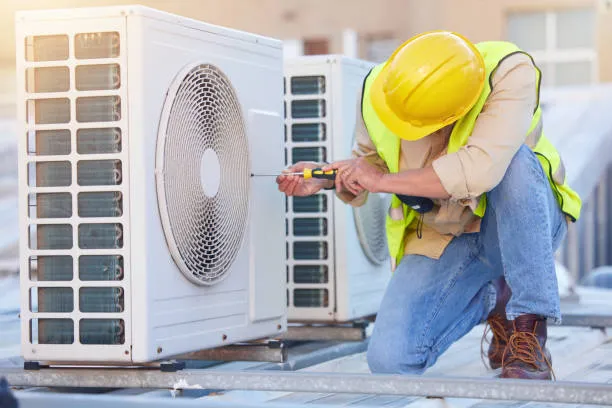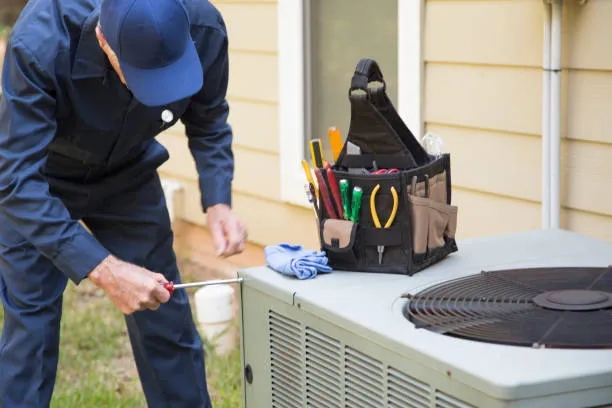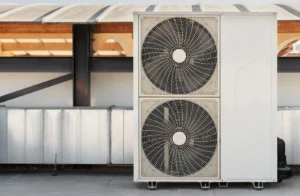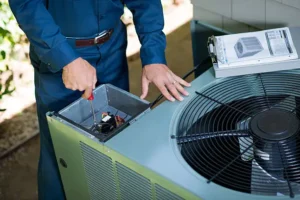Troubleshoot common central air conditioning issues with these easy steps.
There’s nothing worse than walking inside on a hot day, expecting cool relief, only to find warm, stale air drifting from your vents. You check the thermostat. It’s set to cool. You listen, the system is humming. But still, your central air is not cooling.
Before you panic or call for AC repair, it’s worth taking a few minutes to troubleshoot. Many of the most common causes of an AC not cooling can be identified and sometimes, resolved without professional help. This guide gives you a homeowner-friendly checklist to help figure out what’s wrong and what you can do about it.
The No-Cool Checklist: 8 Things to Check Before You Call for Help
Central air conditioning systems are complex, but that doesn’t mean diagnosing problems has to be. When something goes wrong, it could stem from electrical issues, restricted airflow, refrigerant problems, or simple oversight. The good news? You don’t need to be an expert to spot some of the most common issues.
This checklist will help you narrow down the problem so you can either fix it yourself or give your HVAC technician accurate information that saves time and money.
Is the Thermostat Actually Working?
Your thermostat controls everything. If it’s malfunctioning or misconfigured, your AC won’t run properly.
- Make sure it’s set to “Cool,” not just “On” or “Fan.”
- Set the temperature a few degrees lower than the current room temperature to prompt the system to turn on.
- Replace the batteries if it’s battery-powered.
- For smart thermostats, check Wi-Fi connectivity and app settings.
A faulty or incorrectly set thermostat is one of the most common reasons behind a central air not cooling issue.
Is the Air Filter Dirty or Blocked?
If your air filter hasn’t been replaced recently, it could be blocking airflow, making your AC work harder, overheat, or even freeze up, all of which reduce its ability to cool your home.
Remove the filter and hold it up to a light. If you can’t see through it, it’s time to replace it. Over time, filters collect dust and debris, so it’s a good idea to check them monthly and replace them as needed to keep your system running efficiently.
Could a Hidden Safety Switch Be Shutting It Down?
Most AC systems have a float switch or similar safety mechanism that shuts off the system when water builds up in the drain pan. This prevents overflow and water damage.
Take a look beneath your indoor AC unit, which is usually located in a closet, basement, or attic. If you see standing water in the drain pan, the condensate line may be clogged. Try clearing it with a wet/dry vacuum or a vinegar flush. Once drained, your system might start working again.
Is the Indoor Fan Just Sitting There?
If the blower fan inside your home isn’t pushing air, your AC won’t be able to circulate cooled air. Even if the outdoor unit is running, a non-functioning blower means no airflow.
Check if air is coming from the vents. Weak or no airflow usually points to a problem with the blower motor, fan belt, or capacitor. These repairs typically require professional help, but identifying the symptom is valuable.
Check the Circuit Breakers
Your AC system relies on both the indoor and outdoor units to be powered. If one of them trips a breaker, the system may appear to be running but won’t cool.
Inspect your home’s electrical panel to see if any breakers have tripped, and flip them back on if needed. Also, check the small disconnect box near your outdoor unit. If a breaker trips again after resetting, stop and call a technician. This might indicate an underlying electrical fault that needs professional attention.
Any Ice on the Indoor or Outdoor Coils?
Ice buildup is a clear signal something’s wrong. It’s typically caused by low airflow or low refrigerant levels.
Turn the system off and set the fan to “On” to help thaw the ice. Don’t try to chip away at it. If ice keeps forming after the system thaws, it’s time to call for AC repair.
Do You Hear Strange Sounds?
Unusual noises can tell you a lot about what’s wrong.
- Clicking might indicate electrical issues.
- Buzzing or humming may point to a failing motor or capacitor.
- Grinding or screeching suggests a mechanical problem like a worn-out fan or blower motor.
Listen closely and take note of any new or unusual sounds.
Are You Feeling Any Cool Air at All?
Here’s a simple test. Place a thermometer near the return vent (where air is pulled in) and then at a supply vent (where cooled air comes out).
You should see a 15 to 20-degree difference. If the air coming out isn’t much cooler, your system likely isn’t cooling properly, even if it seems like it’s working.

What Most People Miss: Invisible AC Problems That Need Attention
Some issues don’t show up until a professional gets involved, but they’re important to be aware of:
- Incorrect system size: An AC that’s too large or too small will never cool efficiently.
- Leaky ductwork: If ducts are torn or disconnected in the attic, cooled air may never reach your rooms.
- Bad thermostat placement: If it’s placed near a window, oven, or vent, it might be reading the wrong temperature.
- Aging equipment: Systems older than 12 to 15 years may still run, but often lose efficiency and cooling power.
- Zoning issues or poor airflow: Uneven cooling from room to room often points to airflow balancing issues or stuck dampers.
Even if everything “looks” fine, these hidden problems can keep your home hot and uncomfortable.
Quick Q&A: Real Homeowner Concerns
- Why is my central air not cooling even though it’s running?
Likely causes include dirty filters, frozen coils, low refrigerant, or a broken blower fan. Start with the basics like the thermostat and air filter.
- Can I add refrigerant myself?
No. Low refrigerant usually means there’s a leak, and handling refrigerant requires special equipment and certification.
- Why are some rooms cold while others stay warm?
This usually points to ductwork issues, poor airflow design, or a broken damper in a zoned system.
- Is a clogged drain line a serious issue?
Yes. It can trigger a shutoff switch to prevent water damage, stopping the AC from working altogether.
- Can a dirty filter really shut down the system?
Absolutely. It’s one of the most common causes of poor cooling performance and can even cause freeze-ups or blower failure over time.
Conclusion
If your AC isn’t blowing cool air, don’t assume the worst right away. Often, the fix is simple. Running through this checklist can help you avoid unnecessary service calls and get your comfort back quickly. If the problem persists or you find something that looks serious, don’t wait. Professional help can prevent a small issue from becoming a costly breakdown.
At On Point Service Company, we know a hot house can’t wait. If your system isn’t cooling properly and nothing in this checklist solved the issue, our certified HVAC pros are ready to help. We provide fast, honest, and reliable AC repair to get your comfort back without the guesswork. Visit On Point Service Company to schedule your inspection and get cool again, the right way.







